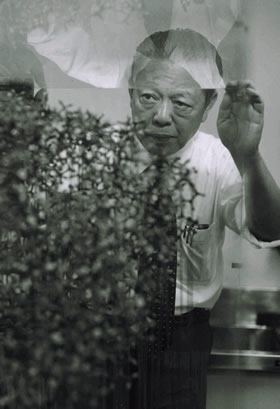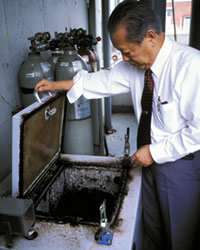 |
| My encounter with chemistry |
 |
 |
My encounter with chemistry came during primary school when a teacher at the school where I was evacuated during the war gave me a real chemistry book used in universities. I read it over and over again until it fell apart. After the war, when I returned to Tokyo, I became even more fascinated by the subject. I performed experiments where we parked bicycles at my house and joined the chemistry club in high school.
I also was interested in living creatures, and I dissected several tadpoles in an effort to find out why their tails disappeared. I wanted to understand living creatures through chemistry and wanted to conduct research of some sort into the origin of life, so I went to NASA after I received my degree. I conducted research there that looked for the origin of life from chemical substances.
|
 |
| My encounter with thermophiles |
 |
 |
I heard from a NASA researcher that there were bacteria in Yellowstone that could multiply in hot springs at temperatures of 80°C. I thought that since the earth in its original state was hot, conducting research into thermophiles might lead to a search for the origin of life. Therefore, I did not hesitate to make my desire known to conduct that research when I returned to Japan. If I could discover new bacteria, perhaps a new biochemical reaction also might be found. Also, enzymes stable under heat are easy to deal with and would be easy to use in applications.
Besides, in the back of my mind I thought that this research was suited to Japan. The country has many hot springs easily accessible by day trips. Also, Japan is different from the United States, where no one goes to hot springs. In Japan, I could find books in the bookstores where I could discover the composition of the water at hot springs throughout the country. Once I knew the elements, it would be easy to create the culture medium to raise bacteria.
After returning to Japan, I became an assistant at the Imahori Laboratory in the University of Tokyo's School of Agriculture. One month later, on the day of the autumnal equinox, I went for a day trip to the Mine hot spring in Izu, secretly taking a ladle with me. It was easier than I thought, because I collected a sample of Thermus thermophillus the first time. I collected this sample from spa water so hot the hand could not be placed in it, so I was overjoyed. I immediately began experiments to put this good fortune to use. |
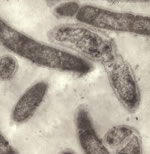 |
An enlarged photograph of Thermus thermophillus, thermophilic bacteria
This thermophilic bacteria discovered at Izu Mine hot springs had a growth temperature of 80°C, the highest discovered at that time.
|
 |
I want to know the entire biochemistry of
thermophiles |
 |
 |
I wanted to know about the mechanisms of living creatures in high temperature environments, so I involved myself in everything related to the biochemistry of thermophiles that I could. First, when I searched for what would be useful for living in a high temperature environment, I discovered that thermophiles had a large quantity of polyamines of a type not found in homo sapiens. Polyamines are related to the activation of the biosynthetic reaction and the stabilization of biological material. Basic polyamines bind with acidic DNA, and likely increase resistance to heat by stabilization. I enjoyed identifying the entire structure of the polyamines in thermophiles and giving a common name to the new substance.
After I moved to the Mitsubishi Kagaku Institute of Life Sciences, I conducted research into tRNA. Kimitsuna Watanabe, currently the director of the Biological Information Research Center of the National Institute of Advanced Industrial Science and Technology, discovered the unusual fact that raising the culturing temperature of thermophiles also would increase the denaturation temperature of tRNA. It had been forecast that it was producing some kind of substance for stabilization, but it was discovered that the DNA modification of tRNA itself changed, and this was important for stabilization. The modified tRNA functioned well at high temperatures. Thermophiles certainly have a superb mechanism of detecting and responding to their environment. After that, I analyzed the X-ray crystallographic structure using the essence of the thermophile protein that was easily crystallized.
Some researchers subdivide specialties by various substances, such as DNA or proteins, but if one wants to know about the nature of thermophilic living creatures, one must look at the whole instead of the parts. I'd like to write a biochemistry textbook that focuses on thermophilic bacteria. |
 |
This is the crystallization of the enzyme in Thermus thermophillus (Isopropylmalate dehydrogenase).
The upper left has an x-ray diffraction photograph. The three-dimensional model identified through an analysis using diffraction photography was displayed in this lab. |
 |
| Microbiology with intermixture |
 |
 |
Lately I have been fascinated by thermophilic bacteria in the soil, not those in water. My interest in soil was triggered by the compost for wastewater treatment in Kagoshima Prefecture. I use it for experiments when its temperature slightly exceeds 90°C. The decomposition speed of organic material is rapid, there is little odor, and it will decompose the corpse of a mouse in about six hours. It has exceptional decomposition capabilities, but the primary bacteria are difficult to culture, impossible to separate, and most cannot be isolated. Even if this were possible, they would be limited to a single generation. Microorganisms create societies with other microorganisms, and most cannot live in isolation.
Microbiology began with Pasteur and Koch. Pure cultures were the foundation for both. Bacteria for which pure cultures can be created are reportedly only 1% of all bacteria, so I think the necessity will emerge in the future for culturing in a mixture. My dream is to create a new microbiology - a microbiology of intermixture. Culturing with compost seems as if it will be useful. Microorganisms are interesting living creatures that provide several areas for research that will be useful in the future.
(Text: Mari Tooyama) |
|
 |
 |
 |
 Looking proud riding the car I loved. Taken about 1936. Looking proud riding the car I loved. Taken about 1936. |
 |
 |
 A chemistry book that I read until it fell apart. A chemistry book that I read until it fell apart. |
 |
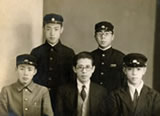 |
 With Mr. Suzuki, who recommended the chemistry book, and a friend I was evacuated with (I am on the right.) With Mr. Suzuki, who recommended the chemistry book, and a friend I was evacuated with (I am on the right.) |
 |
 |
 The Chemistry Club members (I am second from right in the back row.) The Chemistry Club members (I am second from right in the back row.) |
 |
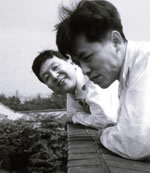 |
 During my graduate school days, with my advisor Dr. Nobuo Tamiya (left). During my graduate school days, with my advisor Dr. Nobuo Tamiya (left). |
 |
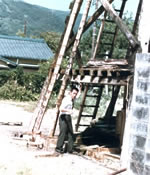 |
 At Izu Mine hot spring where thermus thermophillus was discovered. At Izu Mine hot spring where thermus thermophillus was discovered. |
 |
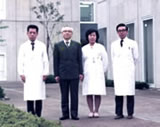 |
 In front of the Mitsubishi Kagaku Institute of Life Sciences. From the left, there is me and Dr. Fujio Egami. In front of the Mitsubishi Kagaku Institute of Life Sciences. From the left, there is me and Dr. Fujio Egami. |
 |
 |
 With Oparin (second from left), the author of The Origin of Life. (I am on the extreme left.) With Oparin (second from left), the author of The Origin of Life. (I am on the extreme left.) |
 |
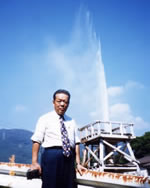 |
 At Izu Mine hot springs. The hot water erupts to a height of 30 meters. At Izu Mine hot springs. The hot water erupts to a height of 30 meters. |
 |
|
